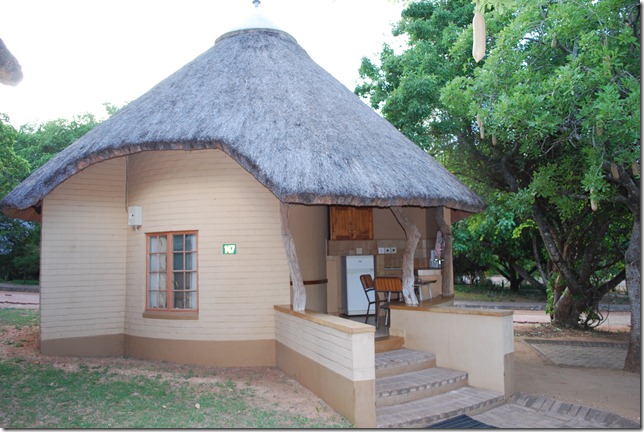I think I’ll try to save you all the trouble of reading about the details of spotting and observing Africa’s large mammal’s (and birds) in the wild and just summarize by saying that Kruger Park was definitely one of the more memorable stops on our voyage. We can heartily recommend an African game park visit. Brian and Monica have been visiting Kruger for 20 years and our 2 day visit was one of the best they’ve had in terms of the number of different and rare species we saw, including 2 leopards in one morning (they’ve seen 4 or 5 and many people have never seen one), a wild dog pack (there are only about 180 wild dogs left in the park), and the large and rare ground hornbill bird catching bugs and then flying up to its nest in the hollow of a dead tree to feed its mate who was sitting on the eggs. Ground hornbills only fly rarely, are monogamous and generally won’t mate if their first mate dies, and are being pressured by the overpopulation of elephants in Kruger, who are pushing down the trees they use for nesting.
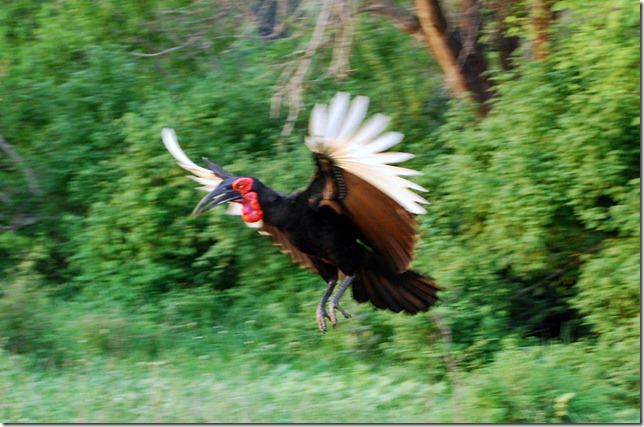 Southern ground hornbill lowers the flaps and landing gear
Southern ground hornbill lowers the flaps and landing gear
There are a number of large camps inside the park with both camping sites and bungalows. The camps are fenced for protection, with gates closing around sunset and opening again with the daylight. We spent both nights in bungalows at Skukuza, one of the larger camps. After breakfast we’d head out for a day of driving slowly along both paved and unpaved roads looking for game or a traffic jam (which means lions or a leopard have been sighted). The bungalows included outdoor kitchenettes and a BBQ, so evenings were spent socializing around a braai.
After saying farewell to Kruger on Sunday afternoon, we drove to a beautiful lodge/bungalow-style hotel called Ya Mati on the banks of a river where Brian had reserved the river cottage. After a dip in the private swimming pool (small, cold and a little dirty, but fun nonetheless) it was time for Braai III, and our skills were definitely improving with a little practice.
In the morning Brian and Monica dropped us off at Moholoholo Rehabilitation Center for a morning tour. The center treats wounded wild animals and does breeding with a few species as well. Animals that can’t be released to the wild or given to a game reserve or zoo are kept on site. Most of the animals were in cages, but it was much more personal than a zoo. We learned about the different species of vultures, each with a neck, head, and beak that is specially adapted to performing a particular part of the “cleaning” of a carcass. For instance, only one species has a beak capable of opening up a carcass, so if the bone-cleaner types show up before them, they just stand around and wait for the sharp-beaked carcass openers to arrive. We had the chance to feed a baby black rhino, and we were able to stand less than a foot from lions growling viciously for their meaty snack It wasn’t a full roar, but from less than a yard away, it was a chilling sound. Only the volcano on Tanna could compare in terms of the raw power of the sound and the way it completely captures your attention, giving you chills even the 2nd and 3rd times you hear it.
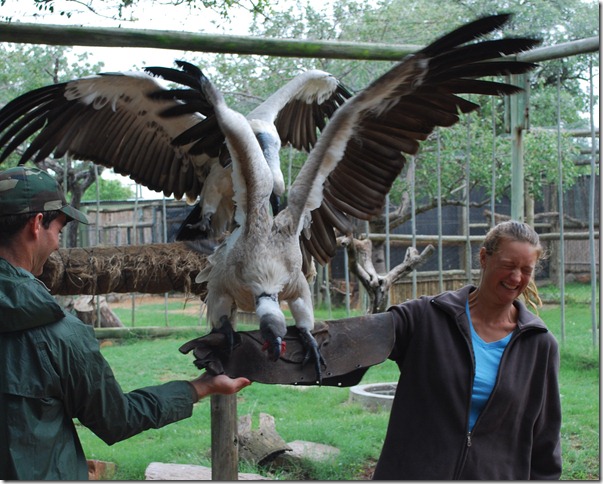 Lauren’s wincing from being brushed by the vulture’s wings as it flew in for the scrap of meat
Lauren’s wincing from being brushed by the vulture’s wings as it flew in for the scrap of meat
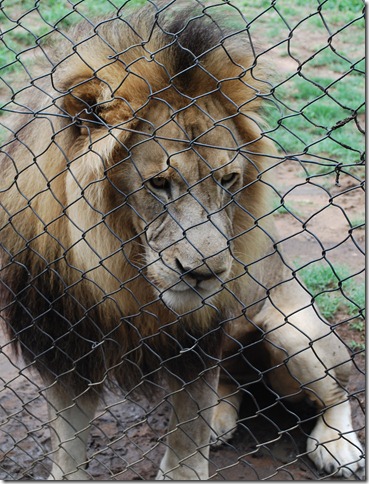 Check out the mangled links for fence in the foreground
Check out the mangled links for fence in the foreground
One of my favorites was the wild dogs. They’re incredibly efficient killers, using their superior endurance to run their prey to exhaustion and then sometimes killing the animal in less than a minute by ripping off pieces of underbelly as it’s running until it succumbs and then bleeds to death. We had a chance to watch them feed on a cow leg that was thrown into their pen, and it’s clear that whoever invented the lion’s den as a form of execution didn’t have access to wild dogs. When hunting (or anticipating a cow leg being thrown over the fence), they start a high-pitched yipping that sounds more like a bird or goose than a dog and their tails, tipped with a bushy white fur, stand straight up. When the leg was tossed into the pen they surrounded it in a frenzy and all bit into it, pulling backwards until a piece ripped off (in Africa, only the hyena has stronger jaws), then swallowed it without chewing and lunged back in to take hold of a piece of the remaining meat. In a minute or two the raucous yipping stopped as the last chunk of meat was gobbled down.
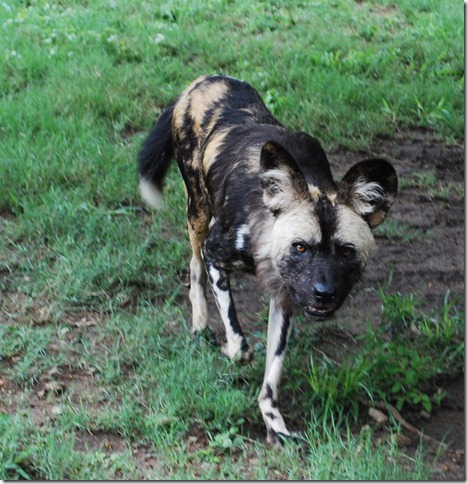 The “devil’s dogs” aren’t the most popular animals in South Africa
The “devil’s dogs” aren’t the most popular animals in South Africa
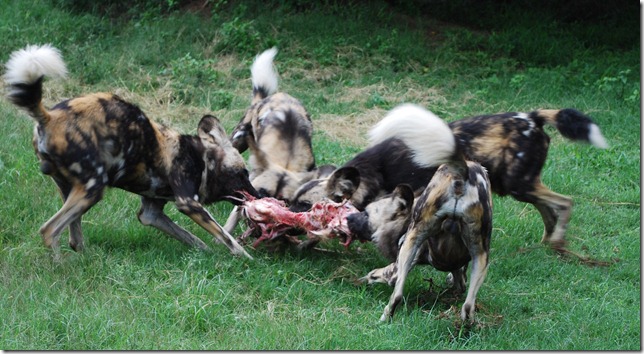 Wild dog table manners don’t take long to learn
Wild dog table manners don’t take long to learn
The most vicious animal in Africa, however, is only a fraction of the size of a wild dog. The honey badger is often bad-tempered and attacks the groin, a technique that has allowed it to kill animals as large as a mature male water buffalo. It’s the only animal that will attack a lion. One of the two honey badgers on site, nicknamed Houdini, once escaped three consecutive times from his enclosure to attack a male lion who was noisy at night. Round 1 went to Houdini, with the lion cowering on top of his shelter when the staff arrived. Round 2 went to the lion the next night, and Houdini was injured pretty badly by time the staff arrived. After stitches and recuperation, Houdini escaped again to attack the lion and this time the staff was able to intervene before things got serious. His escape tricks have been as ingenious as rolling mud in his enclosure into balls and then piling them against the wall until he can climb out and using a newly introduced female honey badger’s back and head as a ladder. He was initially friendly enough to wander among the visitors, but after many “escape wars” that were ended by a wall-top electric fence just like the ones around many urban houses, he’s now has a real dislike for the staff.
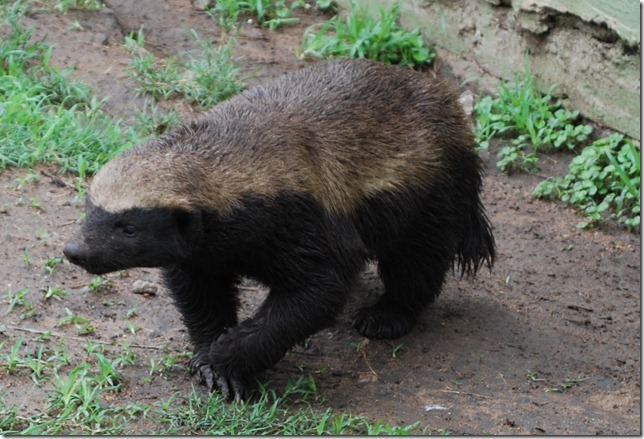 Houdini’s cuddly appearance hides a clever and fearless mind
Houdini’s cuddly appearance hides a clever and fearless mind
We have to say many thanks to Ira, whom I used to work with in California, for introducing us to Brian and Monica from afar and making such a big impact on our stay here. They felt like family by the end of week. Brian and Monica have in turn given us names and numbers for several people along the coast of South Africa that I’m sure will continue to make our experience here a warm and memorable one.
We flew back to Durban today on Mango, one of South Africa’s several discount airlines. By sunset we’d had another visit from Clyde, who’s helping us out with some sail and canvas work and brought over the first of our two trampolines to show us. They’re made from UV-resistant seat belt material and look like they’ll be a big improvement over the death trap we have at the moment. With instructions from the rigger, I was also able to disconnect the forestay and remove the base of the roller furling unit so that we can have new bearings installed.
We learned this week that our South African friends Dave and Shauna of S/V Dragon who had emigrated to New Zealand will be returning to Durban on the 16th, so our departure date is still TBD. For now, there’s plenty of boat work to keep us occupied, and we still haven’t gone a day here in Durban without making a new friend.


